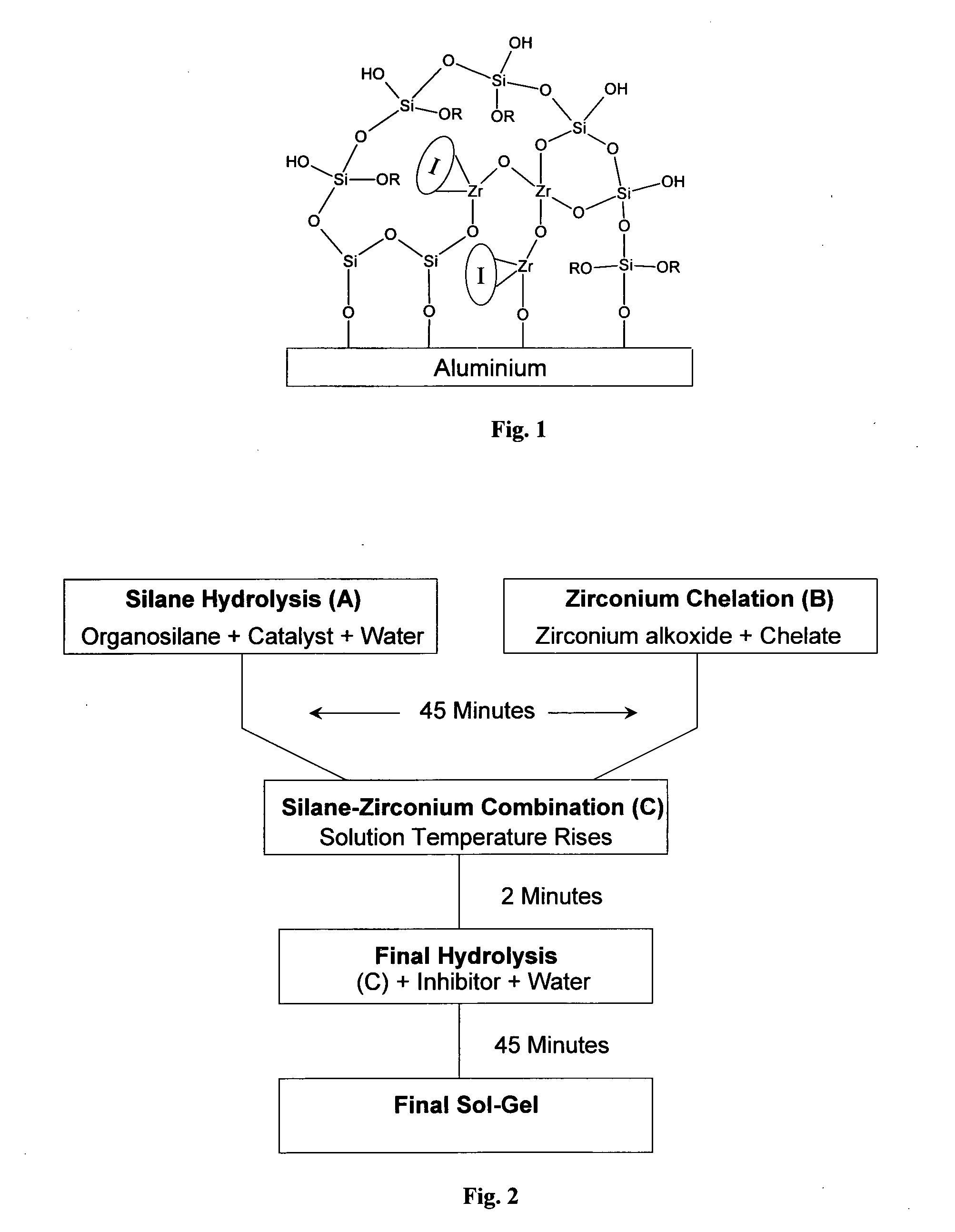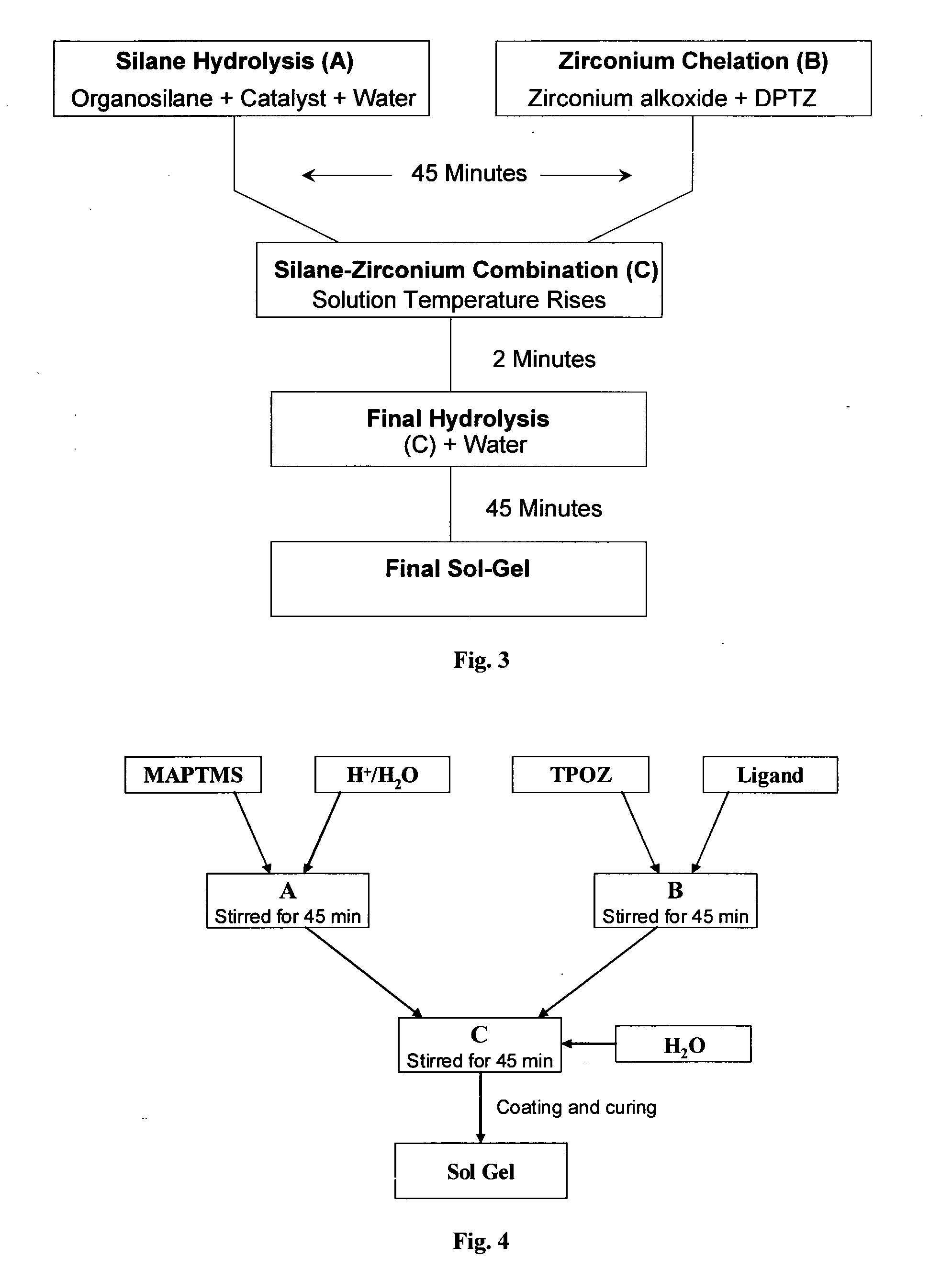Organosilane Coating Compositions and Use Thereof
a technology of organic silane and coating composition, which is applied in the direction of liquid/solution decomposition chemical coating, pigmenting treatment, air transportation, etc., can solve the problems of difficult to maintain a protective barrier coating, the relative reactivity of these alloys to corrosive environments, and the inefficiency of known systems
- Summary
- Abstract
- Description
- Claims
- Application Information
AI Technical Summary
Benefits of technology
Problems solved by technology
Method used
Image
Examples
example 1
Synthesis of Disubstituted Tetrazines
1.1 Synthesis of 3,6-bis(3,5-dimethylpyrazol-1-yl)-1,2,4,5-tetrazine (dmptz)
[0192]The synthesis was performed using a three-step published procedure (Codburn et al., 1991) according to the following scheme:
1.1.1 Synthesis of Triaminoguanidine Monohydrochloride
[0193]Hydrazine monohydrate was added slowly to guanidine hydrochloride (19.1 g, 0.020 moles) in 1,4-dioxane (100 ml) under stirring. The mixture was heated under reflux for 2 hrs. The solution was then cooled to room temperature and the product was collected by Buchner filtration, washed with 1,4-dioxane and dried on the air. The product formed was triaminoguanidine.
1.1.2 Synthesis of 3,6-bis(3,5-dimethylpyrazol-1-yl)-1,2-dihydro-1,2,4,5-tetrazine.
[0194]2,4-Pentanedione (30.0 g, 0.30 moles) was slowly added to triaminoguanidine monohydrochloride (21.09 g, 0.15 moles) in water (150 ml) cooled in an ice-bath. The mixture was heated under reflux for 4 h. During the experiment a yellow solid pr...
example 2
Formulating a Sol Gel with a Ligand as the Chelate
[0212]In this example, methacrylic acid (MAAH) was used as the chelating agent.
[0213]Referring to the flow diagram of FIG. 2:
Organosilane Hydrolysis (A)
[0214]Organosilane hydrolysis was effected by hydrolysing MAPTMS with an aqueous HNO3 0.01M solution in a 1:0.75 volume ratio (below this ratio, precipitation of zirconium species occurred during the second hydrolysis). As MAPTMS and water were not miscible, the hydrolysis was performed in a heterogeneous way. After 20 minutes of stirring, the production of methanol became sufficient to allow the miscibility of all species present in solution.
[0215]Strong complexing ligands have been often used for non-silicate metal alkoxide precursors in order to control hydrolysis condensation reactions (Livage and Sanchez, 1992). Among these strong complexing ligands, MAAH can be covalently bonded to the zirconium atom through two oxygen atoms and a third bond is shared on t...
example 3
Formulating a Sol Gel with the Inhibitor as a Chelate
[0219]In this example, DPTZ was used as the chelating agent.
[0220]Referring to FIG. 3:
Organosilane Hydrolysis (A)
[0221]Organosilane hydrolysis was effected by hydrolysing MAPTMS with an aqueous HNO3 0.01M solution in a 1:0.75 volume ratio. As MAPTMS and water were not miscible, the hydrolysis was performed in a heterogeneous way. After 20 minutes of stirring, the production of methanol became sufficient to allow the miscibility of all species present in solution.
[0222]DPTZ (dissolved in EtOH) was added dropwise to Zr(OPr)4 with a molar ratio of 1:1.
Organosilane Zirconium Combination (C)
[0223]After about 45 minutes (using the above concentrations), the partially hydrolyzed MAPTMS was slowly added to the zirconate complex. This mixture is characterized by a temperature increase, demonstrating the formation of irreversible chemical bonds
Final Hydrolysis
[0224]Following another 2 minutes (using the above concentr...
PUM
 Login to View More
Login to View More Abstract
Description
Claims
Application Information
 Login to View More
Login to View More - R&D
- Intellectual Property
- Life Sciences
- Materials
- Tech Scout
- Unparalleled Data Quality
- Higher Quality Content
- 60% Fewer Hallucinations
Browse by: Latest US Patents, China's latest patents, Technical Efficacy Thesaurus, Application Domain, Technology Topic, Popular Technical Reports.
© 2025 PatSnap. All rights reserved.Legal|Privacy policy|Modern Slavery Act Transparency Statement|Sitemap|About US| Contact US: help@patsnap.com



